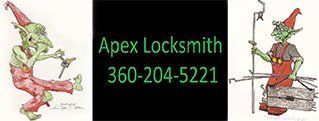Useful Locksmith Terms
Free Estimates | Emergency Services Available | 15 Years' Experience
Free Estimates
Emergency Services Available
15 Years' Experience
Hours:
Helpful Guide to Your Locksmith Services
Not sure what some of the terms pertain to when dealing with locksmith concerns? Learn different lock part names along with the components of a lock and find out what each part does. Check out the terms used below and contact Apex Lockout and Locksmith Services, LLC for all our services.
Our highly trained and knowledgeable team provides excellent customer service for all your locksmith needs.
Locksmith Terminology
Access Control System
A system wherein many parties have access to a common door, gate, or other locked area. A building manager or other administrator has control over who has access and who doesn't, and to what areas. Commonly used in commercial buildings.
Anti-Thrust Bolt
A spring bolt, for a night latch particularly, which cannot be pushed back when it has shot out and fastened a door.
Anti-Thrust Plate
An overlapping metal plate fitted to outward opening doors so as to prevent access to lock bolts. Automatic deadlatch A deadlatch, the main bolt of which is automatically locked (or deadlocked) when the door is closed.
Associated Locksmiths of America
Founded 1955, largest association of its sort in North America, and conducts professional proficiency certifications for its members. They set most of the standards locksmiths need to abide by.
Blade
The portion of the key that is inserted into the lock.
Blank
An uncut key. In the case of transponder keys, a key that is both uncut and unprogrammed.
Cabinet Lock
A generic term to include all locks of any type for use on pieces of furniture, such as cupboards, drawers, chests, boxes and the like.
Change Key
A key that operates only one cylinder or one group of keyed-alike cylinders in a keying system OR any device used to mechanically or electronically allow resetting of certain key or combination locks.
Cylinder Key
A key, having a bow and long blade in which “V” cuts are made along the upper edge to operate the pins and drivers in a pin tumbler mechanism.
Deadbolt
The square-ended bolt of a lock which is moved in both the locking and unlocking directions by the key (but occasionally by thumb turn inside only) to provide fastening. N.B. For obvious reasons, it is inadvisable to incorporate the thumb turn with the deadbolt of any deadlock or lock which is supposed to offer good security, if used on glass or wood paneled doors.
Double-Acting Hinge
A hinge permitting movement of a door in either direction from the closed position.
Double-Handed Lock
A lock designed for use either as a right or left-hand installation without alteration, generally by turning upside down. The keyhole has a circular formation at each end of the slot to accept the shank of the key.
Double Locking
1. By introducing a different cam arrangement into the action of a cylinder rim nightlatch it is possible to give a double or deadlocking facility at no extra cost. A simple opposite turn of the key in the outside cylinder deadlocks both bolt and inside knob simultaneously. This gives protection against the bolt-forcing and the glass or wood panel breaking intruder. 2. Also where a lever lock shoots its bolt by more than one turn of the key, thus doubling the distance of its shoot.
Emergency Key
The key or tool that operates a privacy function lockset.
Exit Device
A door lock/latch mechanism that releases in the direction of exit travel via a bar or panel extending across the major width of the door.
Face Plate
Lock cover plate exposed in the edge of a door.
Furniture
The additional items needed, which are screwed to one or both sides of the door to enable a lock or latch to be manually operated.
Grand Master Key
The key that operates two or more separate groups of cylinders; each is operated by a different master key.
Grand Master Key System
A master key system with three levels of keying.
Great Grand Master Key
The key that operates two or more separate groups of cylinders, each is operated by a different grand master key.
Great Grand Master Key System
A master key system with four levels of keying. Great Grand Master Keyed: A cylinder keyed into a great grand master key system.
Great Great Grand Master Key
The key that operates two or more separate groups of cylinders, each operated by different great grand master keys.
Great Great Grand Master Key System
A master key system with five or more levels of keying.
Great Great Grand Master Keyed
Of a pertaining to a lock or cylinder which is (or is to be) keyed into a great great grand master key system.
Hinge
The joint on which a door or gate swings.
Hinge Bolts
Fixed steel protrusions fitted into the rear edge or hinge side of doors, closing into holes cut into the door frame, to protect from forced attack on the hinge side of the door.
Housekeeper’s Key
A selective master key in a hotel master key system that can operate all guest and linen rooms and other housekeeping areas.
Impression
The mark made by a tumbler on its key cut OR to fit a key by the impression technique.
Jamb
The vertical member of a door or window frame. In some areas, the top rail of a door frame is referred to as the top jamb.
Key Blank
A partly made key, which has been shaped to enter the keyhole of a certain type of lock or latch, but of which the blade has not been finally shaped (i.e. notched or bitted) to operate the mechanism of the lock.
Keyhole
The hole into which the key enters to operate the lock or latch. It is often referred to as the keyway, particularly in a cylinder mechanism.
Laser Key
A key cut using a special laser cutting machine. Cannot be duplicated on regular duplicating machines. Not all locksmiths carry laser cutting technology.
Latch
The type of product with one bolt only, the beveled spring bolt or roller bolt, to latch or fasten the door, but not capable of being locked. Certain types, e.g. locking latches, night latches, or dead latches, can, however, be locked by key or other means.
Lever
A flat shaped movable detainer in a lock, usually for the purpose of providing security and differs. The lever(s) in a lock have to be actually moved by the key to operate the lock. The belly of the lever is cut away to various depths to provide different combinations.
Lock
A device operated usually, but not always, by a key, having one or more bolts or other members to fasten and secure a door, lid, drawer or other member.
Lockable Bolt
A bolt that can be shot and locked in position by the use of a removable key.
Locking Latch
A latch with a beveled spring bolt or roller bolt which is capable of being locked or secured, usually by key.
Lockout
(service) When the locksmith opens a lock of any type. Usually for cars, houses, or apartments.
Master Key
A key which will open every lock in a master keyed suite.
Master Key System
A system in which one "master" key can open all the individual locks in the system, but individual-door keys can only open a single door.
Night Latch
A rim or latch with a beveled spring bolt or roller bolt which shoots when the door is closed, but can be withdrawn by key from outside and by knob or lever handle from inside. Usually provided with a stop knob, slide to hold the bolt retracted and to deadlock the bolt when shot in the closed position, even against the action of the key.
One-Sided Lock (single-entry)
A lock which has a keyhole on one side only, so that it can be operated by key from one side only, usually outside, but not from both. Nearly all cabinet locks and all padlocks are examples. Some high-quality cylinder mortice locks are one-sided.
Padlock
A comparatively small removable and portable locking device, usually but not always key operated on one side only. The locking member is a circular hinged sliding or swiveled shackle which passes through a hole in a staple, locking bar or similar member.
Pattern Key
Any original key kept to use in a duplicating machine when additional keys are required OR any key used in a key duplicating machine to create a duplicate key.
Pre-Assembled Lockset
A lock designed to be installed into a cutout in the edge of a door. The lock body and most or all of its trim need no further assembly other than securing it to the door.
Rack Bolt
A bolt, usually a door bolt, which is toothed so that it may be operated by a pinion.
Re-Key
(service) Manipulate a lock so that different keys open it.
Safe
A lockable container for protecting its contents from fire and/or theft.
Safe Deposit Box
A dual custody container for the storage of valuables; rented to end users by a bank, trust company or hotel.
Safety Lock-Out
A procedure to deactivate or render inoperative any energy device to ensure safety and give visual warning of danger while device is being worked on /locked out.
Skeleton Key
Any non-cylinder key whose bit, blade, and/or post is cut away enough to allow it to enter and turn in locks with different ward arrangements. There is no universal skeleton key. Skeleton keys cannot be made for lever and cylinder lock mechanisms.
Time Lock
A clockwork or electric timing device which disallows operation of a lock or the opening of a door on safes or strongrooms.
Top Master Key
The highest level master key in a master key system.
Transponder Key
(also known as Chip Key or Electronic Chip Key) A vehicle key with an electronic chip lodged in the head. The chip has a code that the car is programmed to recognize. Without a correctly programmed chip in the key, the ignition will not start.
Wall Safe
A safe designed to be installed in a wall.
Wards Fixed
Obstructions inside a lock case to preclude the use of the wrong key, as the key is cut to pass over the wards and operate the lock. They are sometimes used in lever locks to give increased differs. Wards alone give very little security. See “Skeleton Key”.
Warded Lock
Any lock or padlock, the mechanism of which makes use only of wards. Not recommended, due to the lack of security.
Affordable Locksmith Services
Call us today
(360) 370-1091
SERVING
and Surrounding Areas
HOURS
CONTACT US
License Number APEXLL*83405


Share On: